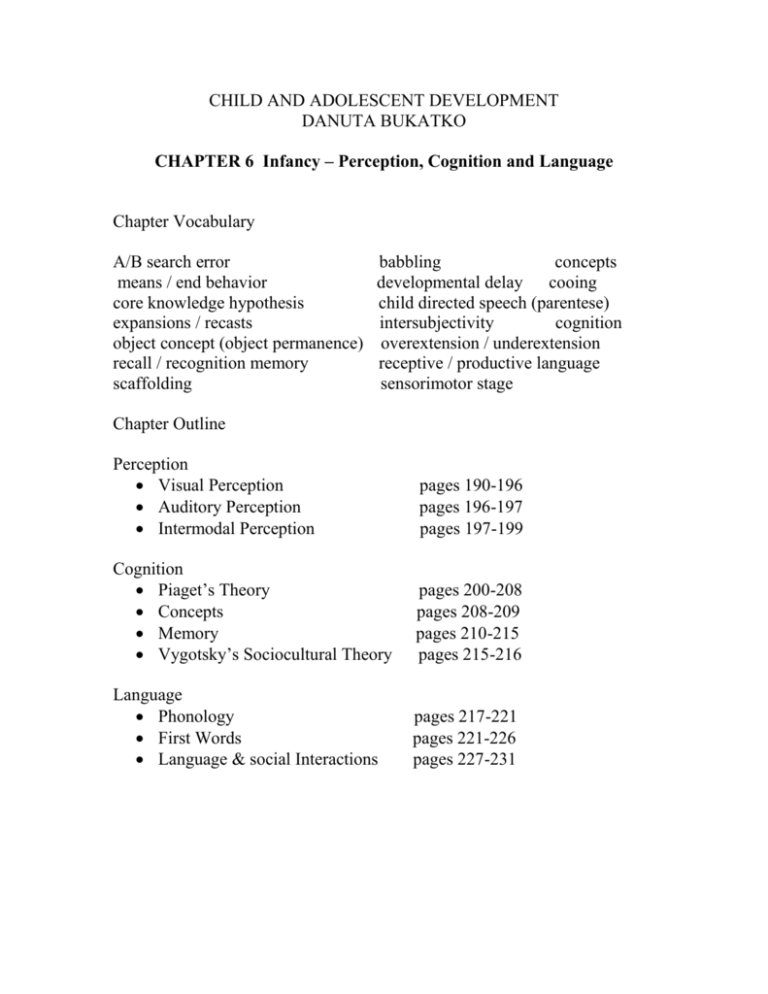CHILD AND ADOLESCENT DEVELOPMENT
advertisement

CHILD AND ADOLESCENT DEVELOPMENT DANUTA BUKATKO CHAPTER 6 Infancy – Perception, Cognition and Language Chapter Vocabulary A/B search error means / end behavior core knowledge hypothesis expansions / recasts object concept (object permanence) recall / recognition memory scaffolding babbling concepts developmental delay cooing child directed speech (parentese) intersubjectivity cognition overextension / underextension receptive / productive language sensorimotor stage Chapter Outline Perception Visual Perception Auditory Perception Intermodal Perception pages 190-196 pages 196-197 pages 197-199 Cognition Piaget’s Theory Concepts Memory Vygotsky’s Sociocultural Theory pages 200-208 pages 208-209 pages 210-215 pages 215-216 Language Phonology First Words Language & social Interactions pages 217-221 pages 221-226 pages 227-231 CHILD AND ADOLESCENT DEVELOPMENT DANUTA BUKATKO CHAPTER 6 GUIDED NOTETAKING OUTLINE Infancy – Perception, Cognition and Language Define perception:______________________________________________ _____________________________________________________________ Define cognition:_______________________________________________ _____________________________________________________________ Perception Which theory of infant perception holds that newborns come equipped with mental mechanisms that help them make sense of sights and sounds? Constructivist or nativist According to constructivist theory, how large are the roles played by nature and nurture in cognitive development? _____________________________________________________________ _____________________________________________________________ According to nativist theory, how large are the roles played by nature and nurture in cognitive development? _____________________________________________________________ _____________________________________________________________ Do infants show a preference for looking at the human face? Explain your answer briefly:________________________________________________ ____________________________________________________________ ____________________________________________________________ The ability to fuse 2 distinct images from our 2 eyes into a perception of a single object is called ______________________. By what age do infants use this ability to get clues to depth perception as effectively as adults do? ____________________. Newborns prefer looking at ____ dimensional objects over ____ dimensional figures. The visual cliff experiments indicate that infants have an early perception of differences in depth. Does this protect them from injury when they start crawling and walking? Y / N Auditory Perception Experiments involving playing music to infants have provided information about infants’ ability to recognize sound patterns. Fill in the blanks to describe one conclusion from such research: At age ___________, infants can________________________________________________________. Researchers continue to be interested in how infants learn speech and language. Complete this sentence: Until 6 month of age, infants are able to distinguish all important sounds from _____________________________ ___________________________________________________________. One issue that has been debated is whether infants possess a “________ _______”, an innate capacity to process human language, or whether infants exploit general ____________ _______________. Define in your own words and give an example: what is intermodal perception? _____________________________________________________________ _____________________________________________________________ _____________________________________________________________ A number of experiments suggest that infants do coordinate looking and listening, and looking and touching. Briefly describe one of these experiments:___________________________________________________ _____________________________________________________________ _____________________________________________________________ Cognition The first stage in Piaget’s theory of cognitive development is called _____________________________. What does this name suggest about how Piaget thought infants obtain information about their world? ____________________________________________________________ This stage covers ages ______________ to ______________________. Since infants develop so much during this age span, this stage is divided into ______ sub-stages. Define object concept (also called object permanence):_________________ _____________________________________________________________ _____________________________________________________________ Piaget thought that children did not begin to fully grasp this concept until ______ months of age. More recent research suggests that infants begin to grasp object concept at ______ months of age. You decide: Based on the information on page 205, do you believe that infants DO or DO NOT possess core knowledge? Explain your position: ___________________________________________________________ ___________________________________________________________ ___________________________________________________________ ___________________________________________________________ The debate over core knowledge echoes (is similar to) a debate described earlier in this chapter. What was that previous debate? _________________ _____________________________________________________________ In Piaget’s theory, what is the A not B search error? ___________________ _____________________________________________________________ Based on your reading in the text, why do you think babies make this error? _____________________________________________________________ _____________________________________________________________ Concepts Children as young as one-year old displayed early classification skills through a spontaneous tendency to ________________________________ ____________________________________________________________ 2 year olds will match items based on _____________ _______________. Infants also show a beginning awareness of quantity. Newborns can detect differences between sets containing _____ objects and sets containing _____ objects. 6 month olds can differentiate between _____ and _____ dots. You decide: Is this apparent sensitivity to number another example of core knowledge? Explain your answer: _________________________________ _____________________________________________________________ _____________________________________________________________ _____________________________________________________________ Memory Think of an example of recognition memory and one of recall memory: Recognition___________________________________________________ Recall________________________________________________________ Name one technique researchers use to study infant memory: ____________ _____________________________________________________________ Under the right conditions, even newborns seem to remember things for as long as_____ hours. As infants mature, memory improves in several ways. Name one improvement in infant memory: ____________________________________________________________ Name 2 areas of the brain that are involved in memory function: 1. 2. Problem Solving Can you remember seeing a real-life problem solving example involving an infant? _______________________________________________________ Vygotsky’s Sociocultural Theory Name a major difference between Piaget’s theory and that of Vygotsky: _____________________________________________________________ _____________________________________________________________ Define scaffolding in your own words, or give a real life example: _____________________________________________________________ _____________________________________________________________ Define intersubjectivity in your own words: _____________________________________________________________ _____________________________________________________________ Language The fundamental sound units and the rules for combining sound units make up a language’s __________________. As well as learning the sounds of a language, infants must also learn the meaning of words. This is called ____________. The smallest units of sound are the basic building blocks of language; these are called _________________. When it comes to language, what can the average 6 month old do better than the average adult? ________________________________________________________ Where is parentese spoken? ______________________________________ What do babies seem to like about this form of speech? _____________________________________________________________ At what age do babies show a preference for the sounds of their own language? ______________ When are babies first exposed to the sounds of their own language? ____________________________ Cooing is _______________________ and starts around age ____________ Babbling is _________________________________ and starts around age _______________. Babies in all cultures begin to coo and babble at similar ages, as a result of ___________________________ factors. They typically say their first word a round age ___________________. In addition to first words, babies also communicate by _________________________. Babies use gestures to get the adult’s ________________ or to get the adult to ________ ___________________. From about 12 – 20 months, most children speak only one word at a time. What type of word is most often used? ________________ Children develop a vocabulary spurt around age _________________. Initially young children make some mistakes in their use of words. Label the types of error in the examples below: A 12 month old only uses the word “doggie” for his family’s pet, not for other canines he sees in the neighborhood. _____________________ An 11 month old calls all the four-legged animals pictured in her book “kitty”.________________________ Define: Receptive language ____________________________________________ Productive language____________________________________________ Which one always develops in advance of the other? __________________ Much of language learning seems to be biologically based, and progresses the same way in all peoples around the world. There is wide individual variation within the normal pattern of development. Some children fall behind the normal range of developmental variation; these children are said to have a __________________ _______________. About ___% of children under age 3 display this delay. Name 2 possible causes: 1. 2. Give a brief overview of what is done for a child with a developmental delay: _______________________________________________________ _____________________________________________________________ _____________________________________________________________ _____________________________________________________________ _____________________________________________________________ Name 3 things parents and caregivers can do to support the language development of infants and toddlers: 1. 2. 3. CHAPTER 6 - INSTRUCTOR’S RESOURCE: Selected Objectives and Quiz Questions from the Study Guide Objectives: 1, 4, 5, 7, 8, 10, 11, 12, 13, 14, 15, 16, 17, 18, 19, 20 Key Terms Review: 2, 4, 5, 6, 9, 11, 12, 14, 16, 17, 18, 19 Fact Questions: 2, 3, 4, 6, 7, 8, 9, 10, 11, 12 Concept / Application Questions: 1, 4, 5, 7, 8, 9, 10, 11, 12







